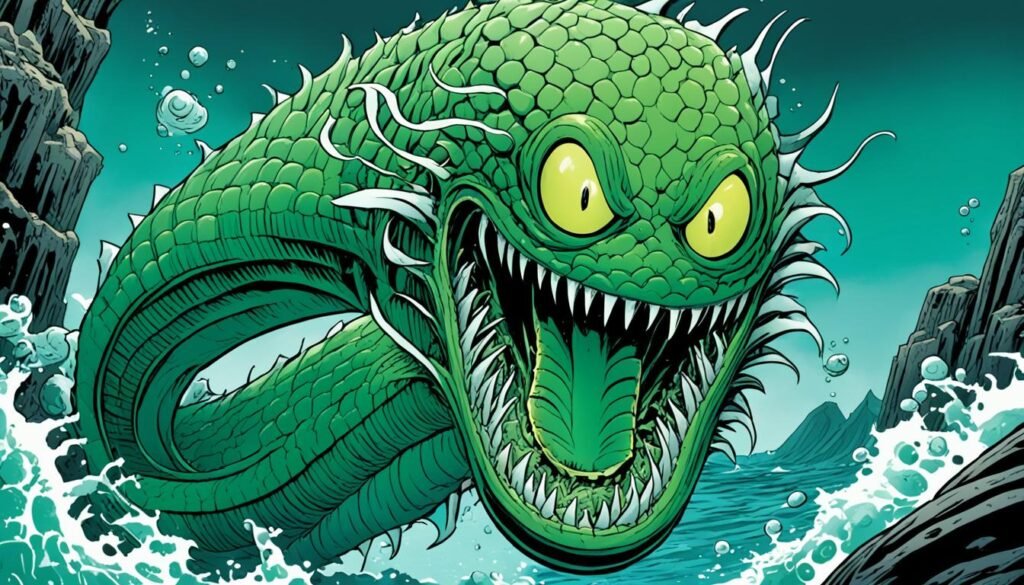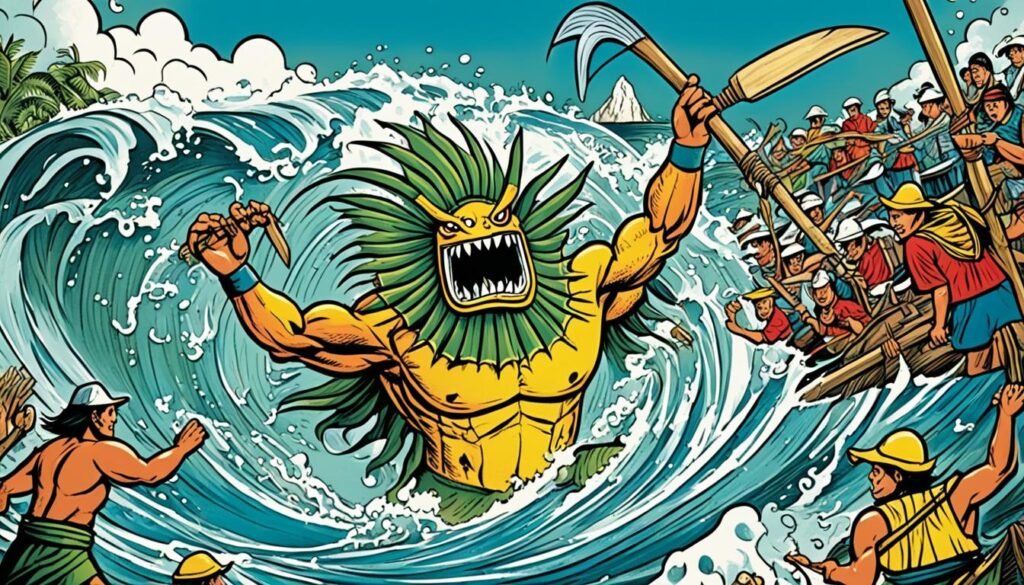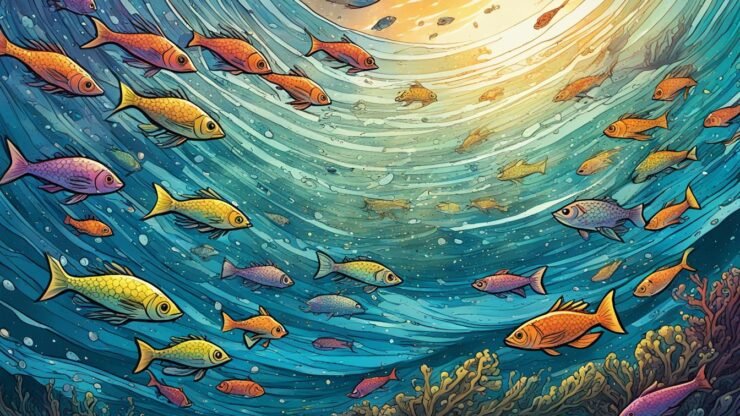In the Philippine archipelago, where blue waters touch the sky, a chilling legend lives on. This story is about the Siyokoy, a frightening merfolk that Filipinos have feared for ages. Dive into the captivating world of Philippine sea mythology, filled with ancient stories that have influenced the country’s culture.
On a dark night, a boat was rocked by powerful waves, its crew fighting to survive. Suddenly, a huge, scary figure rose from the sea. Known as the Siyokoy, this sea creature from Philippine folklore brought disaster to sailors. When the creature vanished, fear lingered, and the sea’s mystery deepened.
Key Takeaways
- The Siyokoy is from Philippine sea mythology, a terrifying underwater figure with a grim reputation.
- This article uncovers the fascinating world of Philippine mythology, showing the Siyokoy’s myth and traditions.
- It details the Siyokoy’s story, appearance, and ties to guardians of the sea.
- It explores how the Siyokoy affected maritime traditions, inspired Philippine art, and remains part of pop culture today.
- The Siyokoy is one of the Bantay Tubig, or “Guardians of the Sea,” a group that watch over the ocean’s mysteries.
The Enchanting Realm of Philippine Sea Mythology
Philippine mythology is full of fascinating tales about the sea. These stories come from the Philippines’ long history. They explain the ocean’s mysteries with stories of mythical creatures. One such creature is the Siyokoy, a scary merfolk who has been part of Filipino culture for ages.
Unveiling Ancient Folklore and Traditions
Philippine folklore showcases the country’s rich culture. It reflects the beliefs of over 140 different groups. These tales include mythological creatures, mystical beings, and even heroes.
Significance in Philippine Culture and Heritage
The Siyokoy and other mythical sea figures are deeply significant in Philippine culture. They show the close bond between the Filipino people and the ocean. These stories not only enrich the nation’s art and beliefs but also its traditions of the sea and spirituality.
Introducing the Siyokoy: A Terrifying Merfolk
In Philippine sea mythology, the Siyokoy stands out. This terrifying merfolk has captured the minds of Filipinos for ages. Contrary to the Sirena and Sireno, the Siyokoy looks more like a beast than a person.
Origins and Legends Surrounding the Siyokoy
The Siyokoy, or Philippine merfolk, come from ancient sea mythology and tales. Legends say they are spirits of the drowned. These spirits turn into aquatic beasts, troubling sailors and fishermen.
Physical Appearance and Bestial Features
The Siyokoy differs greatly from the elegant sirena and kataw. They have fish-like bodies with scales, webbed limbs, and fins. Often shown with long green tentacles and a scaly, monstrous look. They also bring along dangerous animals like eels, octopus, rays, and squids.

Guardians of the Sea: Bantay Tubig
The Philippine seas’ myths go beyond just the mysterious Siyokoy. They belong to the Bantay Tubig, the “Guardians of the Sea.” This diverse group of mythical beings acts as the protectors and rulers of the underwater world.
The Sirena and Sireno: Mermaid Counterparts
Among the Bantay Tubig are the Sirena and Sireno. The Sirena, with a human female’s upper body and a fish tail, is their female counterpart. The Sireno, showing the same aquatic traits, is the opposite. They are known for singing songs that captivate sailors, leading them to danger.
The Kataw: Rulers of the Underwater Kingdom
The Bantay Tubig also celebrate the Kataw, rulers of the ocean depths. These mighty beings guard the sea’s treasures, controlling its tides and currents. They often work with the Sirena and Sireno to watch over the world under the sea.
Siyokoy’s Role in Tragedies at Sea
The Siyokoy, terrifying creatures of Philippine folklore, are thought to cause many sea tragedies. These include shipwrecks and the vanishing of fishermen and sailors. The Siyokoy have been feared as a reason for these events for many years.
Seafarers in the Philippines are scared and respect the Siyokoy deeply. Stories about their dangerous nature as protectors of the deep ocean have been spreading for centuries. These myths have deeply influenced the people’s beliefs about the sea’s dangers.
People tell stories of seeing the Siyokoy just before something terrible happens. They’re believed to take unsuspecting people to the deep sea with them. Their control over the ocean’s currents and their violent nature make them a significant part of Philippine folklore.

Many tragedies at sea are connected to the Siyokoy. The impact of these myths on the Philippines’ coastal areas is strong. The Siyokoy stories remain as a warning about the deep sea’s power.
Mythical Encounters and Cautionary Tales
The Siyokoy has a fearsome reputation in Philippine folklore. Its stories are cautionary tales, warning against the sea’s power and its supernatural creatures.
Folklore Warnings and Superstitions
Filipinos have deep beliefs in sea superstitions and cautionary tales about the Siyokoy. They warn against disrespecting the sea and its guardians. Anyone who goes too far or acts recklessly may face the Siyokoy’s wrath.
Coastal communities warn about the Siyokoy, telling fishermen and sailors to be careful and respectful. These Siyokoy encounters often predict bad events like storms, shipwrecks, or missing people.
Legendary Accounts of Siyokoy Sightings
In Philippine folklore, many have claimed to see the Siyokoy. They tell of its terrifying looks and scary manner, making people fear it.
Some stories say the Siyokoy lures fishermen with its voice, never to return. Others note missing kids and animals, blaming the Siyokoy. These encounters are key in Philippine sea myths, teaching respect and caution towards the ocean and its creatures.
Maritime Traditions and Rituals
Philippine sea mythology, especially the Siyokoy, greatly influences maritime traditions. These traditions have grown over the years. They reflect Filipinos’ desire to live in harmony with ocean spirits like the Bantay Tubig.
Appeasing the Sea Spirits
Coastal communities in the Philippines have unique rituals to please sea spirits. These include making offerings and holding ceremonies. The aim is to keep a balance between people and the supernatural world. They believe this helps ensure safety at sea and good fishing.
Seafaring Beliefs and Practices
Philippine sea myths deeply affect the daily practices of seafarers. They follow superstitions and perform rituals before voyages. This shows their respect for the ocean’s unknowns and its spirits. By doing so, they hope for a smooth journey, blessed by the Bantay Tubig.

Symbolism and Representation in Philippine Art
The Siyokoy and other sea creatures from Philippine myths inspire a lot of art. They are famous in both literature and visual arts. These mythical creatures show the deep cultural ties of the Philippines.
Depictions in Literature and Visual Arts
The maritime symbolism of the Siyokoy stands out in Philippine literature. Writers tell great stories using these mythological creatures. These stories are about people and their connection to the sea.
In visual arts, Philippine mythology is a big theme. It has led to many drawings, paintings, and sculptures. These show the strange and interesting world of the Siyokoy and friends.
Artworks like woodcarvings and murals link the Philippines closely with the sea. The Siyokoy has become a key symbol. It shows how Philippine mythology lives on. Also, it shows how maritime creatures can really capture our minds.
In art, the Siyokoy can be fierce or full of mystery. But always, it is a big part of Filipino creativity. This ensures that the magical stories of Philippine sea mythology stay important. They are a living part of the nation’s culture.
Siyokoy in Contemporary Pop Culture
The Siyokoy and other sea figures from Philippine mythology are not just for fairy tales anymore. They are now big in pop culture. Many stories and art pieces tell their tales in new ways.
In Philippine mythology books, kids’ stories, TV shows, and more, the Siyokoy captures people’s interest. These modern takes keep the old stories alive. They make new fans curious about sea myths.
Maritime mythology continues to be part of today’s pop culture. It shows how these old tales and creatures are beloved. They are loved by people both in and out of the Philippines. This shows their stories still matter and touch many hearts.
Preserving Philippine Mythology for Future Generations
The Siyokoy and other Philippine sea myths are winning over new fans everywhere. People are starting to see why it’s key to keep these tales alive for kids to come. Amid today’s changing world and global challenges, teaching about our deep myth roots is more vital than ever.
Education and Awareness Efforts
In the Philippines, groups and schools are leading the charge to keep our myths alive. With cultural education programs, workshops, and awareness drives, they’re helping spark fresh love for our cultural legacy. The goal is to get young Filipinos excited about their rich myth dust.
Safeguarding Cultural Heritage
But it’s not just about teaching. It’s also about making sure our myth-filled past isn’t forgotten. This means saving info on all the pantheons, deities, and mythical beings that are in our roots. By working with local experts and storytellers, we can leave a rich cultural legacy behind for our kids and their kids.

Exploring Other Mystical Creatures
The Siyokoy is both scary and fascinating. It is one of the many mysterious creatures in Philippine folklore. The country’s stories are rich, not just by the sea. Mystical beings fill the tales with their special stories and powers.
The Diverse Cast of Philippine Mythology
The Philippine folklore introduces us to many interesting beings. From the Kapre who lives in trees to the Manananggal who can change form. There’s the Aswang, which scared even Spanish colonists. They believed in the tiyanak, who brings scary stories into Catholic history.
But not all creatures are scary. There are Diwatas who help crops grow and keep people healthy. We also have the Nuno sa punso. They curse folks who disturb their homes, like anthills, causing trouble.
| Mythical Creature | Description | Significance |
|---|---|---|
| Kapre | A tree-dwelling giant in Filipino folklore | Gained mainstream attention through a Hulu horror anthology episode in 2020 |
| Aswang | A term encompassing different evil monsters such as vampires, ghouls, and witches | Considered the most dreaded fabled animal by Spanish colonists in the 16th century |
| Tiyanak | A vampiric creature in Philippine folklore | Incorporated into Catholicism in the 16th century, expanding to include aborted babies seeking vengeance |
| Sirenas | Ferocious mermaids in the Philippines | Depicted as belonging to the Bantay Tubig (water guardians) alongside other creatures like Siyokoy and Kataw |
| Diwatas | Guardian spirits in Filipino mythology | Called upon ritually for favorable crop growth and health, descending from creatures found in Hinduism and Buddhism |
| Nuno sa punso | Dwarf-like creatures living in anthills or termite mounds in Filipino folklore | Said to curse those who disrupt their homes, causing ailments like swelling or pain |
| Manananggal | A self-segmenting Filipino monster | Detaches her torso to fly at night, preying on pregnant women by sucking out their fetuses |
| Mangkukulam | Sorcerers in Filipino culture | Practitioners of “kulam” or curses, capable of causing harm through supernatural means |
The diverse cast of creatures in Filipino myths is a treasure. It shows how rich and varied the culture is, with stories for every taste and lesson.
Similarities with Other Mythologies
The Siyokoy and other sea myths in the Philippines connect deeply to the country’s culture and land. Yet, they are not alone. Philippine folktales often show similarities to stories from global mythologies.
Parallels and Influences
The Siyokoy looks like a sea creature and acts like a predator. This reminds us of mermaids from tales everywhere, including Greek Sirens and Slavic Rusalka. This shared story may come from people’s timeless love and fear of the sea.
The name Siyokoy hints at Chinese ties, showing how myths mingle over time. The belief in drowned spirits is common in Asia. This shows how stories from different places can mirror one another.
By comparing legends, we can learn more about what makes us all human. These stories show the power of our shared creativity and fears, across centuries and cultures.
FAQ
What are the Siyokoy?
What is the significance of the Siyokoy in Philippine culture and heritage?
How do the Siyokoy differ from other mythical sea creatures like the Sirena and Sireno?
What role do the Siyokoy play in Philippine maritime traditions and rituals?
How have the Siyokoy and other figures from Philippine sea mythology been represented in art and pop culture?
What efforts are being made to preserve Philippine mythology, including the Siyokoy, for future generations?
Source Links
- https://www.kollectivehustle.com/blog/kapreandaswang-filipino-mythology-for-beginners
- http://www.yidff-live.info/en/3943/
- https://en.wikipedia.org/wiki/List_of_Philippine_mythological_creatures
- https://en.wikipedia.org/wiki/Siyokoy_(Philippine_mythology)
- https://en.wikipedia.org/wiki/Sirena_(Philippine_mythology)
- https://factsanddetails.com/southeast-asia/Philippines/sub5_6c/entry-3863.html
- https://allaboutpinas.com/filipino-mythical-creatures/
- https://oldworldgods.com/filipino/lakambakod-philippine-mythology/
- https://en.wikipedia.org/wiki/Mermaid
- https://www.slideshare.net/slideshow/customsofthetagalogs221pdf/257880251
- https://mythicalcreatures.blog/siyokoy-pathfinder-merman-in-philippines-mythology-pics/
- https://philippine-media.fandom.com/wiki/Mermaid
- https://en.wikipedia.org/wiki/List_of_Philippine_mythological_figures

